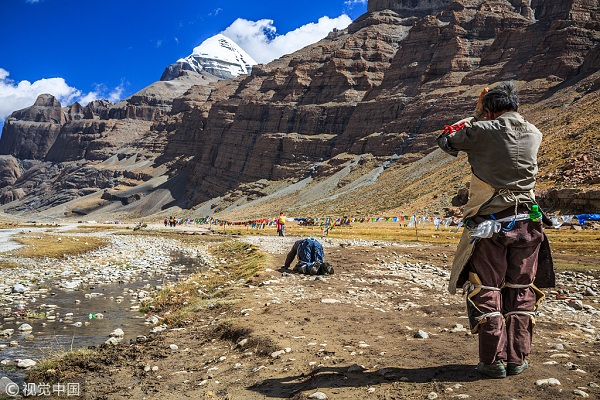Things you should know before kicking off to Tibet

The Tibet autonomous region is located in the southwestern part of China's Qinghai-Tibet Plateau. It covers an area of over 1.2 million square kilometers. The area over 4,000 meters above sea level accounts for 85.1 percent of the total area of the region, which is known as the "roof of the world" and "the third pole of the earth".
The unique geographical environment and historical culture of Tibet create a large number of tourism resources, attracting numerous followers from all over the world to come. A visit to Tibet is one of the most spectacular journeys.
Due to Tibet's special geographic location and unique culture, before you pack and hit the road, let’s get some tips for preparing a visit.
Presenting hada: Presenting hada (a white, loosely woven scarf) is very popular in Tibet. It is a traditional practice of respect and hospitality in Tibet, and will be appreciated by your host. People in Tibet present hada when they visit parents, worship the Buddha, see somebody off, welcome someone home, and so on. Generally, the presenter holds the hada scarf with both arms stretched out evenly before him, and makes a little bow. The receiver should accept it with both hands held in front of himself (but not overly stretched out) and immediately put it on around his neck and wear it. Putting down the hada scarf immediately is considered very rude. However, when presenting hada scarves to seniors, the two arms should be raised up above the head. When presenting hada scarves to people of the same age or younger, the presenter can tie it directly to their necks. This custom is derived from the ancient practice of adorning deities with clothing and has evolved into a greeting of respect and caring.

Taking photographs: Most Tibetans don’t mind having their picture taken, however it is always appropriate to ask for permission first. Some enterprising locals may ask for payment for photos. Don't always assume that giving money to ordinary people to have their picture taken is honorable, (it is often not appropriate) and never take pictures of people who do not want their picture taken. Many Tibetans in rural areas have experienced polaroid pictures so you may have to explain that your digital camera will not deliver images on the spot. If you promise to print and deliver images, please follow through with your promise. Pay close attention to where you can and cannot take photos. Photography is prohibited in places such as inside some monasteries, at celestial burial sites and around military bases.

Cell phone signal: The 4G network was already launched in Tibet. With a total length of 162,100 kilometers of optical fiber cables built, the mobile internet traffic had reached 24.21 million gigabytes in Tibet by 2017. However, the climate change in Tibet is unpredictable, and the mobile phone signal is greatly affected in the stormy or rainy weather. It is also possible that you may not receive any mobile phone signals when climbing over high mountains or crossing through valleys and other special terrain. However, in major cities like Lhasa and Nyingchi, the signal are stable and better, according to latest travelogues and advice posted on Tibet tourism websites by warm-hearted travelers.
Visiting monasteries: Most monasteries are open to visitors. The larger urban monasteries are set up to receive tourists and entrance fees will likely be in place. During certain times of the year some eastern Tibetan monasteries may not accept visitors if it is retreat time. Central Tibet has no restrictions on women entering monasteries although certain Buddhist halls (shrines) may be off limits to women. Visiting monasteries can be one of the most fascinating experiences for travelers in Tibet. When entering monasteries it is appropriate to wear modest clothing: long pants and shirts or tops that are not revealing. Always take off your hat and sunglasses but not necessarily the shoes. Consult your guide or check with the caretaker monk for the dressing code. Smoking is prohibited inside or in the vicinity of a monastery.
Beggars: Giving money to beggars is considered a form of generous practice and is accepted in Tibetan society. On the road you'll often see pilgrims traveling towards Lhasa or Mt Kailash. They finance their pilgrimage through alms. Giving food or money to these hardy folks is considered an act of merit. But handing out sweets or pens to kids could lead to a very unhealthy local-tourist interaction where local kids see tourists as a source of free handouts. If you want to make a contribution, find a worthy organization such as a school or orphanage to donate money where it can be accounted for and used effectively to help those truly in need.

Shopping Tips: The culture of bargaining is strong in Tibet. If you are planning to shop alone, be sure to bargain. The most popular place to shop in Lhasa is the Bharkor Market for Tibetan paintings, handcrafts, jewelry, and ritual objects, etc. Support the local economy by eating and shopping in local restaurants and stores. Buy handicrafts and artwork directly from the artisans when possible, but do not buy wildlife or other endangered flora and fauna products. Most of the market stalls in the Bharkor Square are Tibetan run. Many of the larger shops that sell carpets and jewelry may not be Tibetan owned, although local employees are hired as attendants. If you are hassled by street vendors, there is no need to be angry or aggressive. A firm "NO" will get the message across that you are not interested.
Other tips:
A. Do not eat dog, horse or donkey meat in Tibet. Because Tibetans are typically an nomad tribe, which usually have emotional links with animals that accompany them around.
B. Do not try to inquire lamas about their religions and political stance.
C. Walk clockwise around Barkhor Street, especially during the peak hours of pilgrimage from 9 am to 6 pm.







